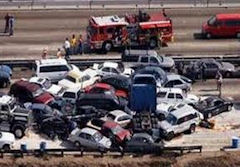by James A. Bacon
The Charlottesville Bypass pile-up keeps getting bigger…
Last night some 300 Charlottesville-area residents packed a meeting at the Holiday Inn to view three design options for the southern terminus of the controversial, $244 million project. After public outcry over flaws in the preliminary design submitted by Skanska-Branch Joint Venture (SBJV) as part of its winning construction bid, the Virginia Department of Transportation (VDOT) last night presented two new alternatives that avoided routing motorists through two traffic lights before accessing the bypass. While VDOT officials said it was too early to attach monetary figures to the new options, Albemarle County Supervisor Dennis Rooker estimated that a flyover alternative would cost an additional $30 million to $60 million. (See Sean Tubbs’ story in Charlottesville Tomorrow.)
Now it appears that there are unresolved problems with the design of the northern terminus at U.S. 29 North and Ashwood Boulevard. More than a half year after VDOT’s central office had accepted the SBJV bid to build the highway, VDOT employees in the Culpeper District office enumerated a number of issues in a technical memorandum dated Jan. 31, 2013, acquired by the Southern Environmental Law Center (SELC) through the Freedom of Information Act.
Key questions centered on the “weave” — a criss-crossing pattern traffic that can create congestion and safety issues — created by the SBJV design. From the memo:
- “Has a weave analysis for motorists exiting the by-pass traveling northbound and merging across 29 northbound to reach the right turn lane at Ashwood Blvd been evaluated?”
- “Has a weave analysis for motorists exiting the by-pass traveling southbound and merging across 29 southbound to reach the left turn lane at Polo Grounds Rd. been evaluated?”
Discussions between VDOT and SBJV ensued. In a letter dated March 19, 2013, also acquired through the Freedom of Information Act, SBJV Project Manager J.J. Moegling suggested that addressing the newly raised issues would cost $13,000 in additional design costs for a northern terminus traffic study, $45,000 for a lane configuration-weave analysis and $500,000 to modify the design of the intersection at Ashwood Boulevard and U.S. 29 — and that’s just counting the design and consulting fees.
Another key issue that had surfaced by that point was how to dovetail the bypass design, which terminated at the Ashwood Boulevard intersection, with a planned widening of U.S. 29 on the other side of the intersection.
Plans for the widening of U.S. 29 that are available now were not available to SBJV during the bid proposal, Moegling said. It is now apparent that SBJV’s proposed location for an extra northbound lane, submitted in its winning bid, does not match up with the proposed lane configuration of a wider U.S. 29 on the other side of Ashwood. Moreover, Moegling contended, “VDOT’s apparent plan [would] create a dangerous merge condition prior to the signalized intersection. … SBJV’s plan did not widen the existing road, but instead restriped the existing lanes to minimize safety hazards….”
In response to VDOT’s contention that the existing right-turn lane into Ashwood Boulevard must be retained, Moegling said that SBJV “is unable to locate language in the RFP that requires this.”
And another bone of contention: “VDOT commented that the weave condition from the US29 bypass to Ashwood Blvd. must be modeled and analyzed; we are unable to locate language in the RFP that requires this. We believe that this model would fail if performed. It is our opinion that the entire intersection would have to be reconfigured in some fashion for this weave to be successful, possibly including an elevated section through the intersection.”
“As you can see,” wrote Moegling, “there are a number of outstanding issues and direction that we need from your office to move forward. … We believe that the order of magnitude to move forward with many of these design initiatives totals in the vicinity of Five Hundred Sixty Thousands Dollars and 00/100 ($565,000).” That number he added, was the direct design cost only and “does not include any markups or associated construction cost as a result of these changes.”
Bacon’s bottom line: Wow. Thirty to sixty million dollars in design changes for the southern terminus. Now potentially millions of dollars more to build an elevated lane at the Ashwood intersection? Holy smokes! This is what you get when you ram a project through the approval process. VDOT did not create this mess, by the way. Mid-level VDOT employees raised red flags throughout the entire process and their concerns were brushed aside. The McDonnell administration owns this fiasco, and VDOT planners and engineers are stuck with the job of making it work.



